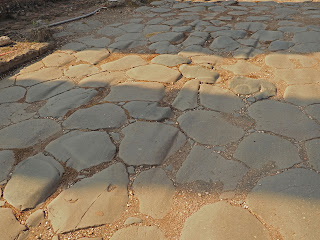This post is dedicated to my friend, the Celebrity Historian.
Okay that is a slight exaggeration. But long-time visitors to this blog know I have posted A LOT of Roman ruins and history posts. (Sample those with the labels on the right of this post of Ephesus, Jerash, Rome, Pergamum, Galilee, and Aphrodisias for past examples. But, in my defense it has been quite a few trips now since I last inundated you with this so I can be forgiven. We will be discussing a number of my favorite topics related to ancient Rome as we visit this, the city of Rome's primary ocean port in the later Republic and early Imperial eras.
Because of the historical nature of this post, I have dedicated to my friend, The Celebrity Historian (CH). He does tons of videos (I've given you a link to his YouTube channel above) that are highly entertaining, yet well researched and documented. My loyal long-term followers know that de-I Sandia Outfitters International History Tours prides itself on doing anything BUT be well researched and documented. Normally, he would vociferously call me out on the SLIGHTEST incorrect fact, wild interpretation, or fatuous historical claim. However, I am protected on this blog as he only looks at it when I put a link to a post on a couple of WhatsApp groups we share AND he only puts his comments in those groups, leaving my actual blog pristine of any fact checking nonsense.
So with that bit of housekeeping out of the way, let's head to Ostia Antica
This is a BIG site. Wife and I walked for hours and we never got to the end of it.
A brief reminder of Roman building philosophy and techniques
Common thinking tends to lump Roman building technique with classic Greek monumental construction meaning the use of stone. The Roman's (especially pre-Empire) built predominantly with brick. Augustus, when he created the Princeps position which evolved to become Emperor, was the first to make use of stone and famously said something like "I found Rome a city of bricks and left it a city of marble".
Roman bricks were thin and layered with different materials.
The brick work was frequently covered and designed.
The Romans had very sophisticated road building techniques
The construction of Roman roads typically involved four main layers, known collectively as via strata:
- Statumen: The base layer made of large stones, approximately 30 cm thick, which provided stability.
- Ruderatio: A layer of rounded stones mixed with lime, which helped bind the structure together.
- Nucleus: A middle layer composed of gravel compacted with heavy rollers, typically around 30 cm thick.
- Pavimentum: The top layer made of large, flat stone slabs that created a durable surface for travel
Clearly we only are seeing the bottom layers among these ruins
Upper stories of Roman buildings that were not monumental were usually made of wood, a reason why they have not survived. Throughout this site there were pictures representing what the city looked like 'back in the day'. What we're seeing now is just remnants of the ground floors.
This picture shows the Forum, the city center. Roman cities followed the same design format. You visit various ruins and this starts to strike you hard. There was not a lot of creativity. There was a great emphasis on efficiency. Where the two major roads of a city crossed, the Forum was built which housed the primary civic (non-private) buildings like the major Temple and the Basilica (which was simply a large government office building - the term was adopted by Christianity for its large, important buildings). In this picture the Basilica is the rectangular building to the left. If you go to Trier, Germany, there is a famous Basilica (later converted to a Cathedral) that was headquarters to Constantine before he marched on Rome to consolidate his control of the Empire. It exhibits the same design.
Looking at the ruins of the Temple and the surrounding important buildings, you can see that brick was the predominant building material used.
One should never forget that Rome was a capitalist based society first. Romans were all about making money. The area around the Theater was where the major trading companies had their headquarters.
I could visualize this being like a Hong Kong of 50 years ago, or Singapore today with the office structures surrounding this common area, each wheeling and dealing.
Like any good corporate structure, even the entryway flooring reflected their activities like shipping and the amphorae which were used to transport liquids like wine and oil.
You have to have places to live in a city. Roman cities were filled with insulae, multi-story structures with many apartments. They typically had an open courtyard to give light and air access to all levels. The ground levels were usually reserved for commercial purposes.
Baths
The public bath was a MAJOR aspect of Roman civic life. Governments and Emperors spent big money building lavish baths that were huge. In Ostia, there are ruins of three of them. The mosaics usually have themes relating to Roman mythical and religious stories.
IMPORTANT REFRESHER FOR FUTURE QUIZ'S
The Doric Capital
The Ionic Capital
The Corinthian Capital
Espouses Fotograficus Antica Romanus
And actual excerpt of de-I/Wife travel. We cannot find each other. She texts me on WhatsApp, "Come to the Statue of the Guy with the Cute Butt".
I am not making this up
Miscellaneous



































2 comments:
definitely worth the trip!! So very large.
That was a wealth of historical knowledge. I will now do my best to forget it, so you can include it in a future blog post without worry.
Post a Comment